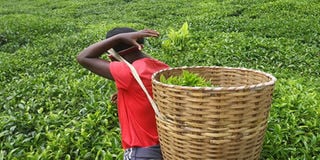How British colonial policy fanned marginalisation

A worker picks tea leaves at Gathehu, in Nyeri County. The region is endowed with fertile soil. PHOTO | FILE | NATION MEDIA GROUP
What you need to know:
- Accidents of history and geography bestowed Central region a cool climate and fertile soils which attracted hordes of white settlers since the dawn of colonialism.
- Discrimination and unfair taxation led to the Somali people's clamour for secession and the Shifta war fought between November 1963 and April 1968.
Over the last one week, Kenyans have been treated to unprecedented political drama with what seems like an open rebellion of some leaders from Central region against President Uhuru Kenyatta marking the crescendo.
Although the controversy appears to mark the beginning of a bigger political game scheme, do Central leaders have a point when they say the region has been neglected in terms of development?
Whenever this question is flagged, many Kenyans want to look at Central as the favoured birthplace of three of the four presidents the country has had since independence.
It is also important to consider that Kenya is a country where ordinary members of communities believe that their fortunes (or “time for eating”) are bound to change whenever one of their own becomes the president.
However, sooner, most of these people end up realising that the “eating” is exclusive.
PRIVILEGE
Do other Kenyans have a point when they say that the Central region has had more than its share of “development” since 1963?
Accidents of history and geography bestowed to the region a cool climate, fertile soils and lush forests which attracted hordes of white settlers since the dawn of colonialism.
The British took by force a significant section of the land there and converted it into the white highlands.
With agriculture forming the bedrock of the colonial economy, the British started opening up roads and other infrastructure in the region as early as 1920s.
Numerous churches and schools were also started in the region by the white missionaries.
Indeed, by the time Kenya became independent, the region had more infrastructure projects than other regions of the country.
COLONIAL POLICY
But what many people fail to acknowledge is that the British launched these projects to exclusively serve them but not the millions of the region’s inhabitants.
The exclusion of millions of Central Kenya residents is as rampant as it is in other regions of the country.
In reaction to the exclusion, millions of Central residents have little to do with the government and prefer to run their own show (that is, farming, small businesses, hawking and the matatu sub-sector).
Nonetheless, those who have compared the highly marginalised regions and Central Kenya have not contextualised this with Kenya’s history.
The marginalisation of more than half of Kenya was a deliberate British colonial policy.
As Nene Mburu says in the book Bandits on the Border: The Last Frontier in the Search for Somali Unity, the British came up with unfair legislation targeting the Northern Frontier Districts (NFD) of Mandera, Wajir, Garissa, Turkana, Marsabit, Moyale and Isiolo.
SHIFTA WAR
Constituting 359,652 square-kilometres, this region represents more than half of Kenya’s total land mass, meaning that more than 50 percent of Kenya was marginalised from the word go.
Besides establishing a military administration in 1919, placing permanent troops in Wajir and Moyale, the British did little else in the NFD.
Instead, they went ahead to declare the region a closed district in 1926 and to issue a series of discriminatory laws which restricted movement in and out of NFD.
Mr Nene says that Britain’s policy on the NFD was informed by the fact that the colonial government believed that the constituent districts offered no clear-cut benefits to London.
The discrimination and unfair taxation not only led to the psychological distancing of Somali people from the political centre, but also constituted the genesis of the clamour for secession and the Shifta war fought between November 1963 and April 1968.
It was also the beginning of what has come to be known as Kenya ‘B’ in some parlance.
INDEPENDENCE
This is the greatly marginalised region that few Kenyans in the other half (or Kenya ‘A’) know little about.
On their part, policymakers have not shown that they really cared about these areas before the formation of devolved governments.
When Kenya became independent, the government of founding President Jomo Kenyatta appeared to follow the “development path” paved by the British.
Armed with little revenue to right the development wrongs, amid enormous expectations, the founding father did not show much willingness to put the marginalised regions at par with the region the British were mostly interested in.
However, the first President was also accused of over-concentrating on the Central region, especially Kiambu district.
Whether this was true or false is neither here nor there.
INDUSTRIES
What is true is that together with the colonial regime, the Jomo era developed industries such as the East African Bag & Cordage Factory in Juja, PanAfrican Vegetable Products Ltd in Naivasha, Uplands Bacon Factory in Limuru area, Thika Taitex Mills and National Pencil Company that produced pencils and matchboxes.
When Daniel arap Moi took over, somehow all of these industries were left to die.
Politicians in the Central region have been asking the government to revive them, as well as the pyrethrum industry, with no success.




